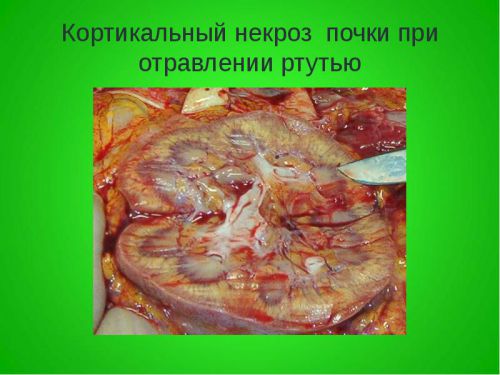kidney necrosis
A large number of people are affected by diseases of the urinary system. Almost every second person has cystitis or pyelonephritis. But these are far from the most formidable processes that can occur. The complications of these diseases are much more severe.
One of them is renal necrosis. This condition is characterized by a violation of the normal structure of cellular proteins, as a result of which the cells themselves begin to collapse.
Why is this happening?
Most often, renal necrosis develops for the following reasons:
- bacteremia, or the entry of bacteria into the bloodstream due to common infectious processes;
- severe dehydration of the body, including with acute diarrhea;
- sublimate poisoning;
- injury;
- necrosis of the epithelium of the convoluted tubules of the kidney can develop in the presence of functional disorders in the functioning of the renal system;
- urinary tract obstruction and bladder infections;
- kidney injury.
Pregnant women should be singled out as a separate group. In them, acute necrosis develops against the background of sudden detachment of the placenta or with anomalies of attachment.
What are the types of necrosis?
All necrosis of renal tissues are divided into 3 types:
- prerenal insufficiency. In this form, there is a violation of normal functioning due to changes in hemodynamics. A decrease in the volume of blood flow leads to further development of the process.
- Renal insufficiency. The renal tubule is damaged due to ischemia. The functions of the organ will also be impaired.
- Postrenal insufficiency. With this type of necrosis, the functional component is not disturbed. The destruction occurs due to damage to the walls of the bladder or ureters, as a result of which the outflow of urine is difficult.
What will be the manifestations?
Symptoms of kidney necrosis appear in the form. The main symptom is a change in the general condition of the patient for the worse. The temperature rises, signs of intoxication of the body appear.
Further, the patient develops paroxysmal pain in the lumbar region, which cannot be relieved with conventional painkillers. The amount of urine excreted is reduced to 50 ml per day. In a clinical analysis of urine, leukocytes are found in large numbers, bacteria, and sometimes even blood.

Cortical vascular necrosis
How to be treated?
Treatment begins with the clarification of the underlying disease, which led to the development of necrosis. The doctor conducts the necessary diagnostic tests to determine the nature of the pathogen and the degree of damage to the tubules.
First of all, broad-spectrum antibiotics are prescribed. After receiving the results of a urine test, it is possible to replace it with a narrower preparation.
If there has been damage to the ureters and bladder, then the causes that caused them are treated. In the presence of a stone, its destruction is performed. In more severe cases, catheterization of the renal pelvis is performed with the formation of a nephrostomy.
Acute process can be removed by hemodialysis. But this method of removing toxins is best left as a last resort, since the clinic does not always have such a device, and excessive transportation of a patient in serious condition is not recommended.
In addition, the general condition of the body is corrected. The lost fluid is replenished, adaptogens and bed rest are prescribed.
From the general recommendations, you can also have a special diet and drink. Spicy and salty foods, smoked meats should be completely excluded from the diet. A diet low in salt and protein is prescribed. You need to drink at least 2 liters of fluid per day so that its amount does not decrease, as diuretics are used.
Kidney disease is a very serious pathology that can lead to a severe deterioration in the quality of life of the patient. All must be treated promptly. Bacteriocarrier is also not allowed, since with a decrease in the body's immune defense for one reason or another, pathogens can become activated. Regular examinations and observations by the attending physician will help prevent the development of serious complications and maintain health.




